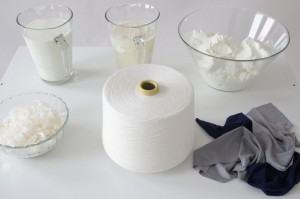Have you heard about QMilch? It’s fabric made from milk! From spoiled, curdled milk! Right here, you can see a very brief description of this fiber. In this picture, you can see various steps in the process that goes from liquid milk to spun qmilch.
While I can’t find a source to purchase the yarn made from milk, I feel sure it will make its way to retail stores in time. Bamboo, corn, and soy are three of the more recent additions to the yarn market over the past few years. Each fiber has its proponents. Producing milk fiber is quite expensive at the present time. But, with more research and a growing number of designers interested in using milk yard goods, the production costs will go down. This is certainly a sustainable fiber source! I look forward to having a chance to work with milk fiber (qmilch) in the future. How about you?


Kollage Creamy is a yarn that says it is 80% milk. It is available all over the internet. Might not be the same stuff though.
I do wonder if this is a faux-eco fiber, much like bamboo. The process to make bamboo yarn is not as green as we like to think the fiber is.
There’s a bunch of milk yarn on Etsy. Here’s one example: http://www.etsy.com/listing/100377733/handspun-luxury-yarn-silken-snow-104m?ref=sr_gallery_11&ga_search_query=milk+silk&ga_view_type=gallery&ga_ship_to=ZZ&ga_min=0&ga_max=0&ga_search_type=all
I have some from diamond luxury collection called Milky Way. It’s 65% viscose, 35% milk sourced viscose. I’m not sure where my friend bought it, but she had to pass it on to me because she had an allergic reaction to it.
In the Western world (and apparenly China too), we produce much more milk than can be consumed (and is therefore with the aid of governments dumped in poor countries, making life hard for the local farmers) so additional uses for milk could be welcome for many groups. And odd fibres are always interesting.
According to one yarn shop that sells odd fibre yarns, including a milk yarn called Viking Pure Milk (from Viking of Norway), during WW2 they tried to make milk yarn in Sweden, but with no success. Due to the restrictions in import during the war, they experimented with all sorts of things to create substitutes for rubber, coffee and much more. And apparently they needed new fibres too.
As for eco-friendliness, all fibres produced according to the same methods as viscose are debated, but many claim they aren’t the worst (comparing with e.g. conventional cotton)and that modern methods are a bit better than they used to be. So hopefully the development will continue in the right direction.